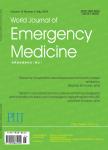Vagus nerve stimulation protects against cerebral injury after cardiopulmonary resuscitation by inhibiting inflammation through the TLR4/NF-κB and α7nAChR/JAK2 signaling pathways
作者机构:Department of Emergency MedicineUnion HospitalTongji Medical CollegeHuazhong University of Science and TechnologyWuhan 430022China Department of Urologythe Second Affiliated Hospital of Guangzhou University of Chinese MedicineGuangzhou 51000China Department of Emergency Medicinethe Second Affiliated Hospital of Zhejiang University School of MedicineHangzhou 310009China Department of Intensive Care UnitWuhan Hospital of Traditional Chinese MedicineWuhan 430000China Department of Intensive Care UnitXiangyang Central HospitalAffiliated Hospital of Hubei University of Arts and ScienceXiangyang 441021China Department of EmergencyGeneral Hospital of Central Theatre Command of the Chinese People's Liberation ArmyWuhan 430070China Department of AnesthesiologyUnion HospitalTongji Medical CollegeHuazhong University of Science and Technology Wuhan 430022China
出 版 物:《World Journal of Emergency Medicine》 (世界急诊医学杂志(英文))
年 卷 期:2023年第14卷第6期
页 面:462-470页
核心收录:
学科分类:1002[医学-临床医学] 100204[医学-神经病学] 10[医学]
主 题:Cardiopulmonary resuscitation Vagus nerve stimulation Inflammation Toll-like receptor 4 α7 nicotinic acetylcholine receptor
摘 要:BACKGROUND: Our previous research proved that vagus nerve stimulation(VNS) improved the neurological outcome after cardiopulmonary resuscitation(CPR) by activating α7 nicotinic acetylcholine receptor(α7nAChR) in a rat model, but the underlying mechanism of VNS in neuroprotection after CPR remains unclear.METHODS: In vivo, we established a mouse model of cardiac arrest(CA)/CPR to observe the survival rate, and the changes in inflammatory factors and brain tissue after VNS treatment. In vitro, we examined the effects of α7nAChR agonist on ischemia/reperfusion(I/R)-induced inflammation in BV2 cells under oxygen-glucose deprivation/reoxygenation(OGD/R) conditions. We observed the changes in cell survival rate, the levels of inflammatory factors, and the expressions of α7nAChR/Janus kinase 2(JAK2) and toll-like receptor 4(TLR4)/nuclear factor-κB(NF-κB).RESULTS: In vivo, VNS preconditioning enhanced functional recovery, improved the survival rate, and reduced hippocampal CA1 cell damage, and the levels of inflammatory mediators after CA/CPR. The application of α7nAChR agonists provided similar effects against cerebral injury after the return of spontaneous circulation(ROSC), while α7nAChR antagonists reversed these neuroprotective impacts. The in vitro results mostly matched the findings in vivo. OGD/R increased the expression of tumor necrosis factor-alpha(TNF-α), TLR4 and NF-κB p65. When nicotine was added to the OGD/R model, the expression of TLR4, NF-κB p65, and TNF-α decreased, while the phosphorylation of JAK2 increased, which was prevented by preconditioning with α7nAChR or JAK2 antagonists.CONCLUSION: The neuroprotective effect of VNS correlated with the activation of α7nAChR. VNS may alleviate cerebral IR injury by inhibiting TLR4/NF-κB and activating the α7nAChR/JAK2 signaling pathway.



